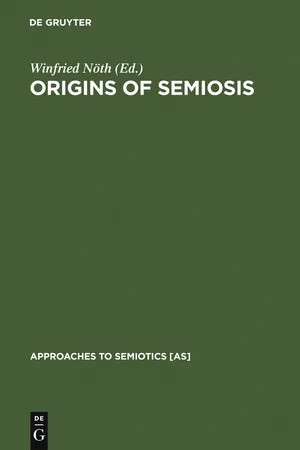
- 518 pages
- English
- PDF
- Available on iOS & Android
eBook - PDF
About this book
No detailed description available for "Origins of Semiosis".
Frequently asked questions
Yes, you can cancel anytime from the Subscription tab in your account settings on the Perlego website. Your subscription will stay active until the end of your current billing period. Learn how to cancel your subscription.
At the moment all of our mobile-responsive ePub books are available to download via the app. Most of our PDFs are also available to download and we're working on making the final remaining ones downloadable now. Learn more here.
Perlego offers two plans: Essential and Complete
- Essential is ideal for learners and professionals who enjoy exploring a wide range of subjects. Access the Essential Library with 800,000+ trusted titles and best-sellers across business, personal growth, and the humanities. Includes unlimited reading time and Standard Read Aloud voice.
- Complete: Perfect for advanced learners and researchers needing full, unrestricted access. Unlock 1.4M+ books across hundreds of subjects, including academic and specialized titles. The Complete Plan also includes advanced features like Premium Read Aloud and Research Assistant.
We are an online textbook subscription service, where you can get access to an entire online library for less than the price of a single book per month. With over 1 million books across 1000+ topics, we’ve got you covered! Learn more here.
Look out for the read-aloud symbol on your next book to see if you can listen to it. The read-aloud tool reads text aloud for you, highlighting the text as it is being read. You can pause it, speed it up and slow it down. Learn more here.
Yes! You can use the Perlego app on both iOS or Android devices to read anytime, anywhere — even offline. Perfect for commutes or when you’re on the go.
Please note we cannot support devices running on iOS 13 and Android 7 or earlier. Learn more about using the app.
Please note we cannot support devices running on iOS 13 and Android 7 or earlier. Learn more about using the app.
Yes, you can access Origins of Semiosis by Winfried Nöth in PDF and/or ePUB format, as well as other popular books in Languages & Linguistics & Linguistics. We have over one million books available in our catalogue for you to explore.
Information
Table of contents
- Introduction
- Part I: Evolution and biosemiosis
- Breathing life into signs: Ways and means of semiosic transition and transformation
- Semiotic principles and systems: Biological foundations of semiotics
- Opposition at the roots of semiosis
- Primate nonverbal communication: Our communicative heritage
- Part II: Anthroposemiotic sociogenesis and cultural semiogenesis
- The problem of certainty in human communication: An evolutionary view
- The culture of nature: The semiotic dimension of microcosm, mesocosm, and macrocosm
- Evolution of human semiosis and the reading of animal tracks
- Analysis of a human releasing mechanism
- Early social games reconsidered: Culture at play
- Infant semiosis
- Part III: Glottogenesis: Phylongeny, ontogeny, and actogeny
- Language and the origin of semiosis
- Language evolution: A Darwinian process
- Deep reconstruction of languages and semantics
- Material time and formal time: Genetically and metagenetically
- The agent and the sentient: A dissymmetry in linguistic and cultural encoding
- Language and brain
- Interchapter
- Structure as idyll: The genesis of meaning in nature
- Part IV: Eikonogenesis and graphogenesis
- Constants in 40,000 years of art
- Deixis vs. modeling in the phylogeny of artistic behavior
- Children’s drawings: Ontogenetic aspects and phylogenetic roots
- Can a picture tell a thousand words? Interpreting sequential vs. holistic graphic messages
- Writing, inscription, and text
- Part V: Appendix
- List of contributors
- Index of names
- Index of subjects